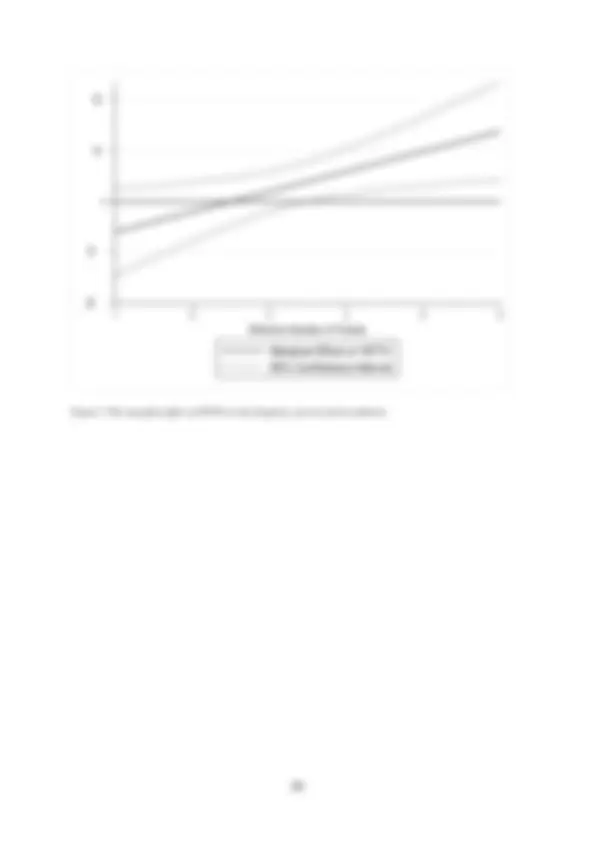




















Study with the several resources on Docsity

Earn points by helping other students or get them with a premium plan


Prepare for your exams
Study with the several resources on Docsity

Earn points to download
Earn points by helping other students or get them with a premium plan
Community
Ask the community for help and clear up your study doubts
Discover the best universities in your country according to Docsity users
Free resources
Download our free guides on studying techniques, anxiety management strategies, and thesis advice from Docsity tutors
A reinterpretation of lijphart’s patterns of democracy in concepts and measures of democratic inclusiveness. From University of Potsdam.
Typology: Summaries
1 / 26

This page cannot be seen from the preview
Don't miss anything!



















Steffen Ganghof University of Potsdam Forthcoming (with minor editorial changes) in
Abstract : This article contributes to the comparative study of democratic inclusiveness by reinterpreting some of Arend Lijphart’s Patterns of Democracy. Three main arguments are advanced. First, Lijphart’s claim that executive inclusiveness follows rather directly from a high effective number of parties is based on incoherent and invalid measurement. Second,executive inclusiveness is best explained in terms of the interaction of a high effective number of parties and strong legislative veto points. This implies that executive inclusiveness cannot be a definitional component of either of Lijphart’s two dimensions of democracy. The interaction effect also supports the assumption that inclusive coalitions are costly to build and maintain. Third, parties have incentives to economize on the costs of inclusiveness byavoiding strong legislative veto points. I argue that these incentives are greater in parliamentary than in presidential systems and show that Lijphart’s data reveal this difference. Hence the parliamentarism-presidentialism contrast plays a greater and somewhat different role for democratic types than Lijphart acknowledges; and his favourite version of consensus democracy, characterized by a parliamentary system and a high degree of executiveinclusiveness, is unlikely to be a behavioural-institutional equilibrium.
Acknowledgements : I thank Arend Lijphart for generously providing the detailed data used in this paper, Sebastian Eppner for excellent research assistance and Thomas Gschwend, Katja Heeß, Marcelo Jenny, Jochen Müller, Ulrich Sieberer, Christian Stecker, Albert Weale, Arndt Wonka and three anonymous referees for helpful comments and suggestions.
Arend Lijphart’s path-breaking Patterns of Democracy distinguishes between majoritarian and consensus democracies.^1 One seminal idea behind this distinction is that countries differ in the inclusiveness of their democratic process. Lijphart measures countries’ democratic inclusiveness along two empirical dimensions, the executives-parties and the federal-unitary dimension, each consisting of five variables. The executives-parties dimension includes an indicator for the inclusiveness of cabinets, which Lijphart considers to be “conceptually close to the essence” of the majoritarian-consensus contrast.^2 I offer a reinterpretation of some of Lijphart’s empirical patterns in the hope of advancing our understanding of democratic inclusiveness. Three interrelated arguments are developed in turn. First, Lijphart claims that cabinet inclusiveness follows rather directly from a high effective number of parties and that it is the empirical core of the executives-parties dimension.^3 I argue that these claims are based on incoherent and invalid measurement, which leads to a misinterpretation of the executives-parties dimension. I suggest that executive inclusiveness cannot be coherently included into this dimension at all (section 2). Second, Lijphart advances the important conjecture that powerful legislative veto points are conducive to executive inclusiveness. I agree and argue that because such veto points are part of his federal-unitary dimension, executive inclusiveness is not a definitional component of one of his two dimensions but a causal consequence of their interaction. I provide evidence for this claim using Lijphart’s original data set.^4 Moreover, whilst Lijphart largely neglects the (^1) Arend Lijphart, Patterns of Democracy: Government Forms and Performance in Thirty-Six Countries (New Haven: Yale University Press, 1999). (^2) Lijphart, Patterns of Democracy , 245. (^3) Lijphart, Patterns of Democracy , 181. (^4) See Lijphart, Patterns of Democracy ; Arend Lijphart, 'Detailed Data used in Patterns of Democracy' (no date), unpublished manuscript, University of California at San Diego.
for overall democratic inclusiveness. If a group is not represented in the assembly at all, it has no resources to influence the formation of portfolio and legislative coalitions. Neither does it have a say, if it is represented in the assembly but completely excluded from the legislative coalition writing and passing the law. In contrast, inclusiveness at the cabinet stage is neither a necessary nor a sufficient condition for democratic inclusiveness. It is not necessary because the inclusiveness of legislative coalitions can compensate for a lack of executive inclusiveness. For instance, a minority government controlling 30 percent of the seats in parliament is very exclusive at the executive stage, but it must build at least minimal winning coalitions in the legislature in order to change the status quo. Executive inclusiveness is also not sufficient for overall democratic inclusiveness because members of executive coalitions may be excluded from the legislative coalition. An important case in point is Switzerland, where a voting coalition of the four permanent cabinet parties is the exception rather than the rule.^5 These observations suggest that the best stand-alone indicator of democratic inclusiveness, proposed by Jack Nagel, is popular legislative support , i.e. the combined vote share of legislative coalitions.^6 Since it measures the inclusiveness of legislative coalitions in terms of votes , it combines information on the two crucial stages of the democratic process. Unfortunately, putting this measure to work in comparative studies is difficult. A core problem is the distinction between routine/technical and important/politicized legislation. Since the former is passed with rather broad majorities in virtually all advanced democracies,
(^5) See André Bächtiger, Daniel Schwarz and Georg Lutz, 'Parliamentary Practices in Presidential Systems? A Swiss Perspective on Governance in a Separation of Powers Framework' (2006), paper presented at the Joint Sessions of the ECPR, Nicosia, Cyprus, 25-30 April 2006, 13-4. (^6) See Jack H. Nagel, 'Expanding the Spectrum of Democracies: Reflections on Proportional Representation in New Zealand', in Markus M. L. Crepaz, Thomas A. Koelble and David Wilsford, eds, Democracy and Institutions: The Life and Work of Arend Lijphart (Ann Arbor, MI: University of Michigan Press, 2000), 121.
adequate measurement would have to focus on the latter. No comparable data on popular legislative support currently exist.
Lijphart’s approach to democratic inclusiveness A crucial feature of Lijphart’s conceptual approach to democratic inclusiveness is that he focuses strongly on the executive stage but neglects the legislative stage. Lijphart conceptualizes democratic types in terms of two latent meta-principles, a consensus and a majoritarian principle. Two of the indicators derived from the consensus principle measure the inclusiveness at the electoral stage: the disproportionality of the electoral system and the effective number of parliamentary parties.^7 A third indicator is meant to capture the inclusiveness at the cabinet stage, where “the consensus principle is to let all or most of the important parties share executive power in a broad coalition”.^8 Lijphart states that this inclusiveness at the cabinet level is the "first and most important characteristic of consensus democracy”.^9 I do not wish to criticize Lijphart’s conceptual focus on executive inclusiveness as such. One could argue, e.g., that being included in the executive gives parties a greater say on policy than merely being included in the legislative coalition. Moreover, the study of executive inclusiveness is certainly interesting in its own right. The problem, however, is that Lijphart implicitly acknowledges the crucial importance of the final legislative stage for overall democratic inclusiveness and therefore selectively includes aspects of legislative inclusiveness into his measure of cabinet types.
(^7) Rein Taagepera, 'Arend Lijphart's Dimensions of Democracy: Logical Connections and Institutional Design', Political Studies , 51 (2003), 1-19, 8. (^8) Lijphart, Patterns of Democracy , 34. (^9) Arend Lijphart, 'Back to Democratic Basics: Who Really Practices Majority Rule?' in Axel Hadenius, ed Democracy's Victory and Crisis (Cambridge: Cambridge University Press, 1997), 144.
weight of MWm and m 1.^14 Lijphart calls this indicator the frequency of minimal winning and one-party governments ( MW/OP ). Based on this indicator he develops one of his crucial empirical claims: that a representative (inclusive) party system tends to translate rather directly into inclusive cabinets.^15 This claim is based on the fact that MW/OP is highly correlated with the effective number of parties ( N ). In his sample of 36 established democracies, N accounts for roughly three-fourth of the cross-sectional variation in MW/OP.^16 Moreover, MW/OP is empirically the central and most important of the five variables constituting the executives-parties dimension.^17 The problem with MW/OP is that ranking (1) cannot be derived from any coherent concept of executive inclusiveness. With respect to their seat share, minority cabinets are clearly exclusive, oversized cabinets are inclusive and minimal winning cabinets are in- between. Lijphart might object that the number of cabinet parties also matters because multiple parties negotiate as equals, whereas intra-party groups negotiate in the shadow of hierarchy. Yet even if this number is also taken into account, ranking (1) does not follow: one-party minority governments are still the most exclusive cabinet type and minimal winning coalitions are still more inclusive than minority coalitions. To get to ranking (1), therefore, Lijphart must again implicitly shift his conceptual focus onto legislative inclusiveness, but only for minority governments. Ranking (1) assumes that one-party minority cabinets tend to build minimal winning coalitions in the legislature and multiparty minority cabinets tend to build oversized legislative coalitions.^18 This selective
(^14) Lijphart adjusts for the length of cabinets. (^15) Lijphart, Patterns of Democracy , 181. (^16) Lijphart, Patterns of Democracy , 112. Note that all empirical results in this paper are based on average values for the period from 1945 to 1996. (^17) Lijphart, Patterns of Democracy , 245. See also Taagepera, 'Arend Lijphart's Dimensions of Democracy', 3. (^18) Lijphart, Patterns of Democracy , 91.
conceptual shift shows in other ways as well: minimal winning coalitions that pass some arbitrary threshold of legislative cabinet support (80 percent) are coded as oversized coalitions,^19 and in one and only one case, Japan, clear-cut majority cabinets are recoded as minority cabinets based on the qualitative inference that the governing party usually tried to build more inclusive legislative coalitions.^20 Hence Lijphart’s indicator is conceptually incoherent: some cases and cabinet types are ranked according to their executive inclusiveness, others according their (partly assumed) legislative inclusiveness. What, then, does Lijphart’s indicator MW/OP measure? An analysis by Taagepera is instructive.^21 It shows that N imposes logical constraints on the feasibility of one-party majority cabinets: if N is below 2, one party must have more than 50 percent of the seats, so this cabinet type must be possible. If N is above 4, this type is logically impossible.^22 Since Lijphart mistakenly treats this cabinet type as being the most exclusive, the logical analysis suggests that his indicator is a complicated proxy for N itself.^23 As Taagepera states, it “supplies a way to visualize the meaning of the effective number of parties”.^24 But this means that the correlation between the two indicators tells us little about the causal relationship between party systems and executive inclusiveness. In fact, while N is highly correlated with the frequency of oversized cabinets as the most inclusive cabinet type (Pearson’s r = .67), it is even more highly correlated with the frequency of one-party minority (^19) Lijphart, Patterns of Democracy , 1 06 - 7. (^20) Lijphart, Patterns of Democracy , 108. (^21) Taagepera, 'Implications of the Effective Number of Parties'. (^22) Given the constraint of a one-party majority, the value for N is greatest when the majority is the smallest possible (50% plus one seat) and the number of minority parties is large. As this number approaches infinity, and the seat share of the minority parties approaches zero, N approaches 4. (^23) Of course, a simpler proxy, directly derived from Taagepera’s logical analysis, would be the frequency of one- party majority cabinets. (^24) Taagepera, 'Implications of the Effective Number of Parties', 234-5, emphasis added.
I contend that the best, albeit imperfect, measure is the frequency of oversized cabinets. Only this cabinet type is consistent with Lijphart’s consensus principle “to let all or most of the important parties share executive power”.^28 The main problem of this measure is that oversized cabinets can be rather narrow in terms of their seat and vote share. But this problem cannot be solved with Lijphart’s data, which only contain information on cabinet types rather than cabinet support. The next section shows that if we focus on oversized cabinets, executive inclusiveness is best explained by the interaction of a high effective number of parties and the existence of at least one powerful legislative veto point.
The previous section argued that Lijphart’s indicator of cabinet types does not measure executive inclusiveness and thus does not add systematic information to the executives-parties dimension. In this section I argue that executive inclusiveness should be excluded from this dimension because it is not only influenced by the party system but also by powerful legislative veto points. And since veto points such as strong second chambers are part of Lijphart’s federal-unitary dimension, it follows that executive inclusiveness cannot be definitional component of one of his two dimensions but is a causal consequence of both.^29 I present evidence for this conclusion on the basis of Lijphart’s original data.
(^28) Lijphart, Patterns of Democracy , 34. (^29) For this conceptual argument see Steffen Ganghof, 'Normative Modelle, institutionelle Typen und beobachtbare Verhaltensmuster. Ein Vorschlag zum Vergleich parlamentarischer Demokratien', Politische Vierteljahresschrift , 46 (2005), 406–31.
Theory In the theoretical and qualitative part of his study, Lijphart suggests that institutional veto power of minorities is conducive to oversized cabinets.^30 This important idea has come to be known as the “Lijphart-Sjölin conjecture” in coalition research.^31 I specify this conjecture by postulating a causal interaction between the effective number of parties and legislative veto points.^32 Moreover, I argue that the interaction effect and its component parts can be explained in terms of the costliness of building and maintaining inclusive coalitions. This analytical focus on the costs of inclusiveness is important because it also provides an explanation for the causal relevance of the effective number of parties. I start with this explanation and then move on to the importance of veto points and the interaction effect. In Patterns of Democracy Lijphart does not discuss causal mechanisms that could explain the hypothesized correlation between N and executive inclusiveness.^33 Rather, he seems to derive this hypothesis from his foundational idea that countries follow one of two latent meta- principles, a majoritarian or a consensus principle, and that the latter implies both a high number of parties and inclusive cabinets. I contend that it is the costliness of very inclusive coalitions that explains why N is positively associated with the frequency of oversized cabinets. Two types of costs seem most important. First, the higher N , the easier it will be for
(^30) Lijphart, Patterns of Democracy , 102-3. (^31) Craig Volden and Clifford J. Carrubba, 'The Formation of Oversized Coalitions in Parliamentary Democracies', American Journal of Political Science , 48 (2004), 521-37, 525. Note that the literature on coalitions typically uses a narrow understanding of this conjecture focused on second chambers. (^32) Interactive effects of party systems and veto points are also visible in other outcomes of democratic politics such as voter turnout and policy outputs. See Mark N. Franklin, 'The Dynamics of Electoral Participation', in Lawrence LeDuc, Richard G. Niemi and Pippa Norris, eds, Comparing Democracies 2 (Thousand Oaks: Sage Publications, 2002); Steffen Ganghof, 'The Political Economy of High Income Taxation: Capital Taxation, Path Dependence and Political Institutions in Denmark', Comparative Political Studies , 40 (2007), 1059-84, 1076- 80. (^33) Lijphart, Patterns of Democracy , 112- 1 3.
parties often choose less inclusive coalitions in order to reduce costs. Yet if veto points require inclusive coalitions in order to change the legislative status quo, parties have no alternative. They only have the choice between building the more inclusive coalition earlier, at the executive stage, or later at the legislative stage. Including as many veto players as possible into the cabinet may have the benefit of making these players more accommodating.^36 Since the causal effects of the effective number of parties and veto points are both based on parties’ cost-benefit calculus, we can expect them to interact. Oversized cabinets are most likely when veto points require oversized legislative coalitions and when a high effective number of parties reduces the costs of building and maintaining oversized coalitions. This interactive specifications of the Lijphart-Sjölin conjecture contrasts with the additive understanding of it that is prevalent in the literature.^37 I submit the following proposition:
Proposition 1. The effective number of parties and significant legislative veto points have an interactive positive effect on the frequency of oversized cabinets, everything else being equal.
Empirical analysis I evaluate proposition 1 with a dummy variable ( VETO ) that takes the value of 1 if a country has at least one powerful legislative veto point and 0 otherwise. It is important to include all potentially relevant types of legislative veto points. The coalition literature focuses only on second chambers and Lijphart’s more comprehensive study also neglects many types of legislative veto points, most notably unicameral minority vetoes, presidential vetoes with (^36) See Steffen Ganghof and Thomas Bräuninger, 'Government Status and Legislative Behaviour. Partisan Veto Players in Australia, Denmark, Finland and Germany', Party Politics , 12 (2006), 521-39. (^37) Volden and Carrubba, 'The Formation of Oversized Coalitions in Parliamentary Democracies', 529.
supermajoritarian veto override, and referendum vetoes. His omission of Finland’s unicameral minority veto is particularly noteworthy because Lijphart uses this case to develop the Lijphart-Sjölin conjecture.^38 Prior to 1992 the Finnish constitution had given one-third of the members of its unicameral parliament a legislative veto. While technically only a suspensive veto, Lijphart emphasizes that laws could, in part, be deferred until after the next election.^39 This made the veto comparable to an absolute veto, especially with respect to cabinet formation. I include the following veto points: Strong bicameralism : Australia, Germany, Switzerland and the US are counted as strongly bicameral based on Lijphart.^40 Supermajority decision rules in at least one “strong” chamber : Such rules are very rare, but exist in the US (Senate filibuster) and used to exist in Colombia (1958-74) as well as in Finland (prior to 1992) as explained above.^41 Presidential veto : Colombia, Costa Rica, and the US are counted as having strong presidential veto rights in ordinary (non-financial) legislation, i.e. vetoes that can
(^38) Lijphart, Patterns of Democracy , 103. (^39) Lijphart, Patterns of Democracy , 103. (^40) Lijphart, Patterns of Democracy , 212. (^41) See John M. Carey, Octavio Amorim Neto and Matthew Soberg Shugart, 'Appendix: Outlines of Constitutional Powers in Latin America', in Scott Mainwaring and Matthew Soberg Shugart, eds, Presidentialism and Democracy in Latin America (Cambridge: Cambridge University Press, 1999); Björn E. Rasch, 'Parliamentary Floor Voting Procedures and Agenda Setting in Europe', Legislative Studies Quarterly , XXV (2000), 3-23; Torbjörn Bergmann, Wolfgang C. Müller, Kaare Strom and Magnus Blomgren, 'Democratic Delegation and Accountability: Cross-national Patterns', in Kaare Strom, Wolfgang C. Müller and Torbjörn Bergmann, eds, Delegation and Accountability in Parliamentary Democracies Oxford University Press, 2003), 114-6.
cabinets can be accounted for by the effective number of parties alone. Model 2 introduces the veto point dummy and an interaction term, which increases the explained variance to 53 percent. Two cases have a large effect on the fit of the model. One is Austria, all of whose “oversized cabinets” in the data set are in fact minimal winning but have been reclassified by Lijphart due to their high share of seats in the legislature.^46 The other country is Mauritius – an unusual case that is also a clear outlier in the correlation between N and Lijphart’s indicator of cabinet types ( MW/OP ).^47 The fairly high share of oversized cabinets in this country seems to result mainly from pre-electoral coalition-building in response to a highly disproportional electoral system.^48 If these two cases are dropped, explained variance jumps to 74 percent, as shown in the final column.
[Figure 1 about here]
To explore the interaction effect in more detail, it is prudent to use the results for the entire sample. N has a statistically significant positive effect for both values of VETO. However, in the absence of a powerful veto point one additional effective party increases the frequency of oversized cabinets by 11.5 percentage points, whereas a powerful veto point increases this effect to 27.3 percentage points (11.5 + 15.8). To interpret the effect of VETO , a marginal effects plot is useful (Figure 1). When N is around 2, the effect of a strong legislative veto point is indistinguishable from zero and statistically insignificant. As N increases,
Wooldridge, 'Econometric methods for fractional response variables with an application to 401(k) plan participation rates', Journal of Applied Econometrics , 11 (1996), 619-32. (^46) Lijphart, Patterns of Democracy , 106, Fn. 6. (^47) Lijphart, Patterns of Democracy , 112-3. (^48) Henry Srebrnik, ''Full of Sound and Fury': Three Decades of Parliamentary Politics in Mauritius', Journal of Southern African Studies , 28 (2002), 277-89, 279.
however, so does the positive effect of VETO , reaching statistical significance when N is around 3.5 or greater. Qualitative evidence also corroborates the interaction effect. The two countries combining strong legislative veto points with a high effective number of parties are Finland (until 1992) and Switzerland. Country experts agree that powerful veto points were a crucial contributing cause of very frequent oversized cabinets in both countries.^49 Finland also contrasts nicely with other Nordic cases which share many of Finland’s political and institutional features but are set apart by the absence of a significant veto point and a high frequency of minority rather than oversized cabinets.^50 Australia represents the combination of few parties and a powerful veto point, the Senate, in which the government typically lacks a majority. Contrary to what additive specifications of the Lijphart-Sjölin conjecture would lead one to expect, parties in the House of Representatives do not form oversized cabinets in order to absorb the Senate as an institutional veto player. Instead, they build flexible legislative coalitions in the Senate, often relying on minor parties not represented in the House.^51
(^49) On Finland, see Jaakko Nousiainen, 'Finland. The Consolidation of Parliamentary Governance', in Wolfgang C. Müller and Kaare Strøm, eds, Coalition Governments in Western Europe (Oxford: Oxford University Press, 2000). On Switzerland, see Wolf Linder, Swiss Democracy - Possible Solutions to Conflict in Multicultural Societies (London: Macmillan, 2002). (^50) See David Arter, Democracy in Scandinavia. Consensual, Majoritarian or Mixed? (Manchester/New York: Manchester University Press, 2006), 86-108, 258-75. (^51) See Stanley Bach, Platypus and Parliament: the Australian Senate in Theory and Practice (Canberra: Department of the Senate, 2003); Ganghof and Bräuninger, 'Government Status and Legislative Behaviour', 533-
I suggest that we can apply the idea of a behavioural-institutional equilibrium not only to electoral and party systems but to democratic types in general. To develop such a perspective, the first and crucial step is to apply it to the mutual relationship between legislative institutions and coalition-building. Just as parties often have incentives to remove institutional constraints on their pre-electoral behaviour, they may also have incentives to remove institutional constraints on their post-electoral behaviour, i.e., to avoid, weaken or abolish veto points. The strength of these incentives depends on the extent to which legislative veto points do indeed imply the requirement of inclusive coalitions. I submit that a crucial contextual factor in this regard is the form of government. Powerful legislative veto points are likely to be a more severe constraint on coalition- building in parliamentary systems, for two reasons. First, the most important decision rule in a parliamentary democracy is the one applied to the vote of non-confidence procedure. The easiest way to induce inclusive cabinets would therefore be to give a minority a veto over the cabinet. Yet since inclusive cabinets are costly, and since cabinet instability is a major problem in parliamentary democracies, the vote of non-confidence procedure is everywhere based on majority rule. But this implies that a minority veto in ordinary legislation creates severe tension: it either turns into a de facto veto over the cabinet, leading to cabinet instability, or it creates a sort of democratic deficit, as a cabinet having a clear popular mandate and enjoying assembly confidence may see its legislative program blocked by a legislative minority. Second, the disunity of parties and coalitions tends to be greater in presidential systems, and this disunity can be a different mechanism to reduce the inclusiveness and hence the costliness of legislative coalition-building. It allows for inter-party and inter-branch coalitions
of like-minded legislators, whilst excluding less like-minded legislators in all parties.^53 A certain degree of party disunity may be an important part of the behavioural-institutional equilibrium in presidential democracies with significant legislative veto points. With respect to Lijphart’s sample, two main implications follow. One, parliamentary systems were less likely to have powerful legislative veto points, because constitutional designers had either avoided them from the start or weakened them prior to 1945, the starting year of Lijphart’s period of investigation. Two, if a parliamentary democracy did have a powerful institutional veto point, a strong reform stimulus was likely and more likely than in presidential systems. These two implications can be combined as follows:
Proposition 2. Parliamentary systems are less likely to have legislative veto points that give veto power to minorities. If they do have them, the resulting reform stimulus will be greater than in presidential systems, everything else being equal.
Empirical analysis Proposition 2 is also corroborated by Lijphart’s data. Consider first the distribution of veto points. Of 36 cases only five were presidential,^54 but four of them (80 percent) had at least
(^53) See Scott Mainwaring and Matthew Soberg Shugart, 'Conclusion: Presidentialism and the Party System', in Scott Mainwaring and Matthew Soberg Shugart, eds, Presidentialism and Democracy in Latin America (New York, NY: Cambridge University Press, 1997), 418-21; Tsebelis, Veto Players , 84- 5. (^54) I focus on the most important difference between parliamentary and presidential systems, i.e., whether or not governments can be removed by the assembly for political reasons. Switzerland is treated as a presidential system because the cabinet cannot be removed. It is a very special case, however, because the collegial, multi- member cabinet is elected by the assembly.